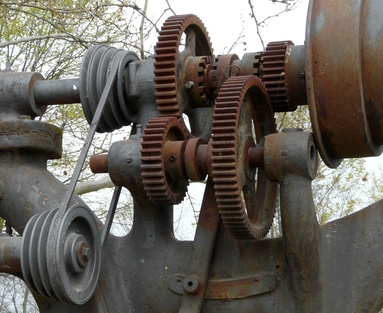
Gear trains provide either torque or velocity multiplication between input and output. As torque increases, velocity decreases proportionately. Examples of applied gear trains are vehicle transmissions and gear drives in machines, appliances and tools. Calculating the output/input relationships of gear trains is generally systematic and straightforward
Define the gear train application. In this case, a high-speed DC motor is being used to power a 2,000-pound cable winch for the front of an ATV. If the winch has a retrieval rate of six feet per minute, the full cable drum diameter is three inches and the motor has a stall torque of 0.5-foot-pounds, you can calculate the overall ratio of the multi-stage gear train to drive it.

Calculate the torque required to turn the drum at rated capacity. With a wind drum diameter of three inches (radius = 1.5-inches), the torque required to generate the 2,000-pound pulling force tangentially to the outside of the wound cable is 2,000 pounds x 1.5-inches/12-inches/foot-pound = 250-foot-pounds.
Calculate the overall gear train reduction ratio to provide the necessary torque. Dividing the 250-foot pounds required torque/0.5-foot-pound stall torque of the motor yields a reduction ratio of 500 to 1. The drum would have to be rotating at six eet x 12-inches/foot/9.42-inches per rpm or 7.56-rpm. 7.56-rpm x 500-to-1 gear ratio = 3780-rpm for the motor operating fully loaded.
Define the overdrive application. In this example, a 3,600-rpm, 10-horsepower electric motor will be used to drive a centrifugal compressor at 18,000-rpm. With this information you can calculate the torque delivered to the compressor.
Calculate the overall ratio required. Dividing 18,000-rpm by 3,600-rpm = 5. The gear train will require a five times larger gear to drive the small one. So if the large gear has 100 teeth, the smaller has 20 teeth.
Calculate the torque available to the compressor. Since the motor has 10-horsepower, and its speed is 3600-revolutions per minute (rpm), the motor torque can be calculated with the AC motor equation Torque = hp X 5252/rpm. Substituting known values, Torque = 10-hp X 5252/3600-rpm = 14.66-foot-pounds. While the overdrive gear train has raised rpm, it changes torque as the inverse proportion, so 14.66-foot-pounds/5-to-1 reduction ratio = 2.92-foot-pounds available to the compressor.